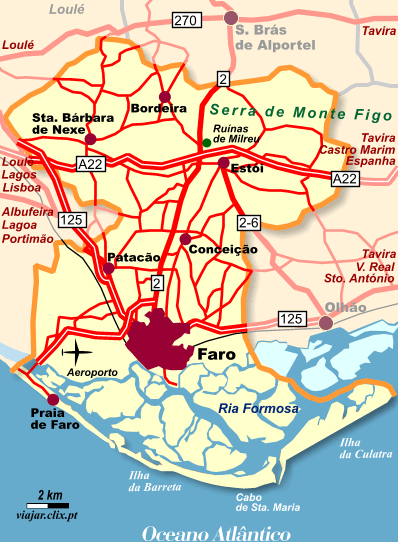Portugal | Algarve | Faro | Faro |
Español | Français | Português | Text | Photos | Videos | Restaurants
Español | Français | Português | Text | Photos | Videos | Restaurants
Faro

Choose a county
 The capital of Algarve boasts of a lively centre filled with shops, esplanades, bars and restaurants together with interesting monuments and museums and fine buildings, mainly from the 18th and 19th centuries.
The capital of Algarve boasts of a lively centre filled with shops, esplanades, bars and restaurants together with interesting monuments and museums and fine buildings, mainly from the 18th and 19th centuries. The reason for this is that although Faro became an important port and center under the Romans, after having been a Pre-historic fishing village, it suffered the occupation of the Moors, was burnt and sacked by the English in the 16th century and greatly damaged by the devastating earthquake of 1755.
The reason for this is that although Faro became an important port and center under the Romans, after having been a Pre-historic fishing village, it suffered the occupation of the Moors, was burnt and sacked by the English in the 16th century and greatly damaged by the devastating earthquake of 1755. Faro was largely rebuilt and some of the finest architectural examples can be seen between the center of the city and the Largo do Carmo square, such as the Bivarin Palace.
Faro was largely rebuilt and some of the finest architectural examples can be seen between the center of the city and the Largo do Carmo square, such as the Bivarin Palace. Many sites are worth visiting: the Largo da Sé square, with its fine buidings, the 18th-century bishops' palace and the rich cathedral; the Church of Saint Peter, dedicated to the patron saint of fishermen and with a magnificent baroque main altarpiece; the curious Jewish Cemitery, dating from the 18th century; Arco da Vila, an arch built on the place of a medieval castle gate in the 18th century; Arco do Repouso, another arch, this one of Moorish origin, etc.
Many sites are worth visiting: the Largo da Sé square, with its fine buidings, the 18th-century bishops' palace and the rich cathedral; the Church of Saint Peter, dedicated to the patron saint of fishermen and with a magnificent baroque main altarpiece; the curious Jewish Cemitery, dating from the 18th century; Arco da Vila, an arch built on the place of a medieval castle gate in the 18th century; Arco do Repouso, another arch, this one of Moorish origin, etc. Tourists can also visit the Municipal Museum, housed in a former convent and displaying local archaeological discoveries; the Maritime Museum, exhibiting a curious collection of models of boats; and the Etnographic Museum, showing Algarve's traditional customs.
Tourists can also visit the Municipal Museum, housed in a former convent and displaying local archaeological discoveries; the Maritime Museum, exhibiting a curious collection of models of boats; and the Etnographic Museum, showing Algarve's traditional customs. Between São Brás de Alportel and Faro, the small and quiet village of Estói is known for its surprising palace in the Rococo style, built between the mid-1840's and completed in 1909.
Between São Brás de Alportel and Faro, the small and quiet village of Estói is known for its surprising palace in the Rococo style, built between the mid-1840's and completed in 1909. The gardens have orange trees and palms, fountains and statues, and there are two pavillions, the blue and white tiled Casa da Cascata and, on the main terrace, Casa do Presépio, with stained-glass windows and fountains adorned with nymphs and beautiful decorated tiles picturing pastoral scenes.
The gardens have orange trees and palms, fountains and statues, and there are two pavillions, the blue and white tiled Casa da Cascata and, on the main terrace, Casa do Presépio, with stained-glass windows and fountains adorned with nymphs and beautiful decorated tiles picturing pastoral scenes. Near Estói, the Roman ruins of Milreu date from the 1st and 2nd century AD and are worth visiting, although many archaelogical findings have been transferred to the Municipal Museum in Faro.
Near Estói, the Roman ruins of Milreu date from the 1st and 2nd century AD and are worth visiting, although many archaelogical findings have been transferred to the Municipal Museum in Faro.
| Pousadas (1) | Hotels (9) | Inns (2) | Pensions and Boarding Houses (10) | Youth Hostels (1) | Manor & Farm Houses (1) | Resorts and Apartments (1) | Private Houses (2) |
City maps
Faro, Faro Centre
